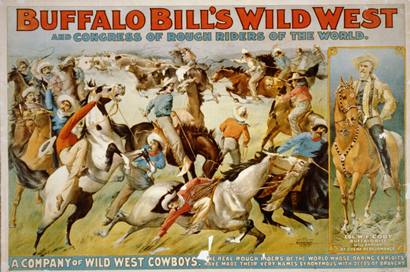Books by
Michael Barr
Order Here: |
|
|
For
most of the 19th century the word "cowboy" was a derogatory term,
attached to desperadoes and shiftless range bums who roamed the
west, but a tall ranch hand from Fredericksburg
helped transform the cowboy from an outlaw into a cherished American
icon.
William Levi
"Buck" Taylor was born in Fredericksburg,
Texas on October 15, 1857. His father died in the Civil War,
and his mother died soon after. Various friends and relatives raised
the three Taylor children: Mary, Buck and Baxter. Mary grew up in
Willow
City.
Buck learned to ride horses and work cattle at an early age. Like
many of his profession, he was a drifter. The unattached romantic
life was one of the advantages of his line of work. That freedom
to come and go on a whim was one of the allowances made to cowhands
by ranchers in exchange for short pay and few benefits.
In
the 1880s Buck drifted north to Nebraska. While working on Major
Frank North's cattle ranch on the Dismal River near North Platte,
Buck met North's flamboyant partner, William Frederick "Buffalo
Bill" Cody.
Cody, along with everyone else, was impressed with the tall Texan.
At a time when the average height of a man was well under 6 feet,
Buck Taylor stood 6 feet 4. He was handsome and athletic with wavy,
shoulder-length hair. He could rope and throw a wild steer and ride
the rankest mustang with astonishing ease.
When Buffalo Bill began his Wild West Show in 1883, Buck Taylor
was the first ranch hand Cody hired.
|
 |
Buffalo Bill's
Wild West Show poster
Wikipedia
|
|
Buck Taylor
toured the world with "Buffalo Bill's Wild West Show." He rode broncs
and performed amazing tricks on horseback. Cody billed him as "The
King of the Cowboys."
Buck became a major star along with Annie Oakley and Sitting Bull.
Fans mobbed Buck when he walked down the street in New York, London
and Paris.
As Buck's fame
grew, Cody upgraded Buck's image. Buck began appearing in public
wearing fancy embroidered vests, spotted chaps and a pearl-handled
six-shooter.
Cody, of course, wasn't interested in truth. He wanted to sell tickets,
and he created alternative facts to suit his purpose. The transformation
of the cowboy from fact to myth had begun.
|
Buck Taylor as
Custer at Little Big Horn.
Wikipedia
|
|
Newspaper stories
planted by Cody, described Buck as "the brave orphan boy from Texas,"
pure at heart and always fighting for good. He was strong but shy.
He was tough as nails yet "amiable as a child" and always kind to
women.
Then in 1890 western writer Prentiss Ingraham was searching for
the subject of his next story. Prentiss wrote dime novels - a wildly
popular genre of hastily-written fiction, issued in cheap paperback
form for mass market consumption. Buck Taylor, the handsome western
cavalier, was the perfect choice.
Ingraham produced a series of dime novels featuring "Buck Taylor,
King of the Cowboys." Titles included "The Prince of the Lasso,"
The Saddle King" and "Red Riders of the Rio Grande." Ingraham's
fictional cowboy was no longer a villain but a medieval hero, slaying
bad guys and rescuing damsels in distress.
The image caught on and began to spread. Just as the Buck Taylor
dime novels hit the street, romanticized images of the cowboy, painted
by Frederick Remington and Charlie Russell, grabbed the attention
of the public. In 1902 Owen Wister published The Virginian,
a novel that established the classic western format used in books
and western movies throughout the 20th century. Zane Grey's western
novels, with the cowboy as the hero, sold 40 million copies and
inspired 112 movies.
Just as the era of the real cowboy came to an end, the era of the
romantic cowboy began. By the turn of the 20th century the cowboy
had been transformed from a no good outlaw into a knight on horseback
- the purest symbol of courage, honor, chivalry and individualism.
By 1950 the transformation was complete. The cowboy had become the
symbol of everything good about America and the central figure in
the American myth.
It all began with Buck Taylor, the original cowboy hero.
© Michael Barr
"Hindsights" March
2 , 2017 Column
Sources:
"Cowboy is most popular folk hero," Wichita Falls Times, April 20,
1975.
"Borderline," Burkburnett Informer Star, June 25, 1992.
"Sheepherders should get recognition," Brownfield (Texas) News,
April 30, 1986.
"King of the Cowboys," The (London, England) Evening News, August
22, 1887.
True West Magazine, "Buck Taylor, King of the Cowboys," May 22,
2015.
|
|
|
